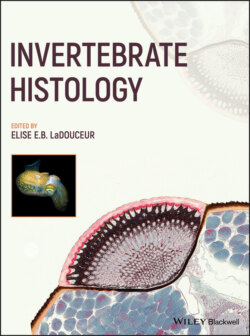Читать книгу Invertebrate Histology - Группа авторов - Страница 12
1.1 Introduction
ОглавлениеPhylum Echinodermata consists of three subphyla (Asterozoa, Echinozoa, and Crinozoa) and five main classes. Subphylum Asterozoa contains two extant classes: Asteroidea (sea stars, sea daisies) and Ophiuroidea (brittle and basket stars). Echinozoa contains two extant classes: Echinoidea (sea urchins, sand dollars) and Holothuroidea (sea cucumbers). Subphylum Crinozoa contains only one extant class: Crinoidea (feather stars, sea lilies). There are 7000 living species of echinoderms (Mulcrone 2005). All are marine and almost exclusively benthic. Some subphyla are mobile (Asterozoa, Echinozoa) and others are sessile (Crinozoa), though some sea lilies have been documented to swim significant distances. Echinoderms do not appear to have near relatives among other invertebrate phyla.
Most members of Echinodermata are dioecious and undergo sexual reproduction, with a few species reproducing asexually. Holothuroids are gonochoric (Leake 1975). Asexual reproduction through fragmentation may occur in some Asteroidea and Holothuroidea due to trauma or predation. The diet varies widely by class, with Asterozoa being carnivorous, Echinozoa and Crinozoa being vegetarian browsers and filter feeders, and Holothuroidea being detritivores. Significant conservation concerns and anthropogenic stressors include commercial fisheries, which impact diet availability, particularly clams, mussels, and oysters, and the pet trade through individual animal collection and the collection of coral and live rock causing habitat loss. Environmental concerns include habitat destruction and direct animal impacts due to ocean acidification. Population declines due to disease such as the Caribbean Diadema antillarum mortality event in 1983–1984 (Carpenter 1990; Lessios 2016) and “wasting disease” events across multiple species of asteroid (Hewson et al. 2014; Menge et al. 2016) have more recently received significant focus. Certain Asteroidea are keystone species in their ecosystems, critical for controlling prey populations and diversity. Echinoidea and Holothuroidea are of paramount importance to marine ecosystems because of respective roles in counteracting macroalgal competition with corals, and recycling nutrients from decaying organic matter.
